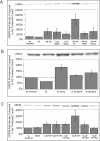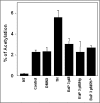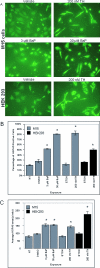Activation profiles of HSPA5 during the glomerular mesangial cell stress response to chemical injury
- PMID: 17915553
- PMCID: PMC1971237
- DOI: 10.1379/csc-259.1
Activation profiles of HSPA5 during the glomerular mesangial cell stress response to chemical injury
Abstract
Environmental injury has been associated with endoplasmic reticulum (ER) stress, a response characterized by activation of the unfolded protein response, proteasomal degradation of proteins, and induction of HSPA5, also known as GRP78 or BiP. Although HSPA5 has been implicated in the stress response to environmental injury in several cell types, its role in the glomerular ER stress response is unknown. In this study, we evaluated HSPA5 activation profiles in rat glomerular mesangial cells (rGMCs) challenged with heavy metals (HgCl2 or Pb2+ acetate) or polycyclic aromatic hydrocarbons (PAHs, ie, benzo(a)pyrene [BaP]). Challenge of rGMCs with 1 or 10 microM HgCl2 or Pb2+ acetate increased HSPA5 mRNA and protein levels. The induction response was sensitive to transcriptional and translational inhibition by actinomycin D (AD) and cyclohexamide, respectively. HSPA5 mRNA was induced by 3 microM BaP in an AD-sensitive manner, but this response was unaffected by the presence of heavy metals. A promoter construct containing sequences that mediate thapsigargin (TH) inducibility of the HSPA5 promoter was refractory to both heavy metals and BaP. The HSPA5 induction response in rGMCs is conserved because it was reproduced with fidelity in immunolocalization experiments of HSPA5 protein in M15 and HEK293 cells in embryonic lines of murine and human origin, respectively. Collectively, these findings identify HSPA5 in the stress response of rGMCs and implicate regulatory mechanisms that are distinct from those involved in TH inducibility.
Figures







Similar articles
-
Uric acid-induced endoplasmic reticulum stress triggers phenotypic change in rat glomerular mesangial cells.Nephrology (Carlton). 2013 Oct;18(10):682-9. doi: 10.1111/nep.12127. Nephrology (Carlton). 2013. PMID: 23841795
-
Endoplasmic reticulum stress induction of the Grp78/BiP promoter: activating mechanisms mediated by YY1 and its interactive chromatin modifiers.Mol Cell Biol. 2005 Jun;25(11):4529-40. doi: 10.1128/MCB.25.11.4529-4540.2005. Mol Cell Biol. 2005. PMID: 15899857 Free PMC article.
-
Thapsigargin down-regulates protein levels of GRP78/BiP in INS-1E cells.J Cell Biochem. 2012 May;113(5):1635-44. doi: 10.1002/jcb.24032. J Cell Biochem. 2012. PMID: 22189689
-
Localization and function in endoplasmic reticulum stress tolerance of ERdj3, a new member of Hsp40 family protein.Cell Stress Chaperones. 2004 Autumn;9(3):253-64. doi: 10.1379/csc-52.1. Cell Stress Chaperones. 2004. PMID: 15544163 Free PMC article.
-
New progresses on cell surface protein HSPA5/BiP/GRP78 in cancers and COVID-19.Front Immunol. 2023 May 18;14:1166680. doi: 10.3389/fimmu.2023.1166680. eCollection 2023. Front Immunol. 2023. PMID: 37275848 Free PMC article. Review.
Cited by
-
Protein Drug Targets of Lavandula angustifolia on treatment of Rat Alzheimer's Disease.Iran J Pharm Res. 2015 Winter;14(1):291-302. Iran J Pharm Res. 2015. PMID: 25561935 Free PMC article.
-
Effects of UVB-induced oxidative stress on protein expression and specific protein oxidation in normal human epithelial keratinocytes: a proteomic approach.Proteome Sci. 2010 Mar 18;8:13. doi: 10.1186/1477-5956-8-13. Proteome Sci. 2010. PMID: 20298559 Free PMC article.
-
RNA-sequencing analysis of TCDD-induced responses in zebrafish liver reveals high relatedness to in vivo mammalian models and conserved biological pathways.PLoS One. 2013 Oct 30;8(10):e77292. doi: 10.1371/journal.pone.0077292. eCollection 2013. PLoS One. 2013. PMID: 24204792 Free PMC article.
-
The inhibition of ORMDL3 prevents Alzheimer's disease through ferroptosis by PERK/ATF4/HSPA5 pathway.IET Nanobiotechnol. 2023 May;17(3):182-196. doi: 10.1049/nbt2.12113. Epub 2023 Jan 20. IET Nanobiotechnol. 2023. PMID: 36680386 Free PMC article.
-
Characterization, Stress Response and Functional Analyses of Giant River Prawn (Macrobrachium rosenbergii) Glucose-Regulated Protein 78 (Mr-grp78) under Temperature Stress and during Aeromonas hydrophila Infection.Animals (Basel). 2021 Oct 19;11(10):3004. doi: 10.3390/ani11103004. Animals (Basel). 2021. PMID: 34680024 Free PMC article.
References
-
- [ATSDR] Agency for Toxic Substances and Disease Registry. 1999 Toxicological Profile for Mercury. Department of Human Health Services, Washington, DC. - PubMed
-
- ATSDR. 2005 Toxicological Profile for Lead. Department of Human Health Services. Washington, DC.
-
- Baker EL Jr, Goyer RA, and Fowler BA. et al. 1980 Occupational lead exposure, nephropathy, and renal cancer. Am J Ind Med. 1:139–148. - PubMed
MeSH terms
Substances
LinkOut - more resources
Full Text Sources
Molecular Biology Databases
Miscellaneous
